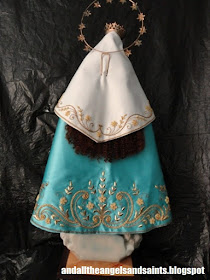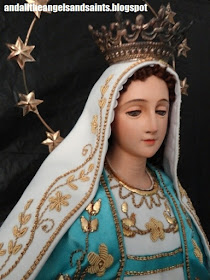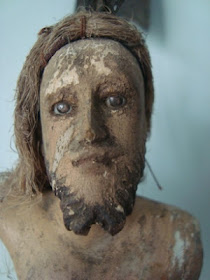When my favourite antique dealer sent me a photo by phone of a newly-arrived 2-foot santa for my consideration, I really got excited. For here is a very rare image of Our Lady of the Miraculous Medal, or known by its other title--Our Lady of Grace, the titular patron of our town, Mabalacat.
Though I already have a 16 in. image, it is a reconstruction, fashioned from an Immaculate Conception santa. But clearly, this larger image is an original Milagrosa, with metal parts unbelievably complete—from the brass rays that emanate from her hands, to her crown and 12-star halo. She still had her sky blue cape in velvet, plus her sparsely embroidered tunic in shabby but stable condition.
Though her encarna had started to flake, one could discern her fine facial details, that can only be described as serenely beautiful.
The santo stood on a base of wood, but the clouds were made from composition or paper mache, reinforced with gauze, which have started to show. A snake lay coiled underfoot, which fortunately was undamaged, right down to the apple in its jaws.
This was the way that St. Catherine Laboure saw Our Lady in a vision at Rue-de-Bac, France in 1830. She stood with a downcast glance, and was dressed in a blue cape, white mantle and tunic. Rays emanated from her hands, both outstretched at her side. Beneath her feet, a serpent lay crushed and around her were the words ”O, Mary conceived without sin, pray fpr us who have recourse to thee”.
A medal was struck based on this vision, and miracles were soon being wrought. The devotion to Our Lady of the Miraculous Medal was introduced by the Vincentian fathers with their arrival in the Philippines in 1860, catching on in popularity in no time at all. Recollects propagated the devotion in our town as early as the 1860s under the title, Ntra. Sra. De la Gracia.
As late as the 1930s, an image of La Virgen Milagrosa had stood on the main altar with her signature rays radiating from her hands, to be replaced in the 1950s with a seated image of a Madonna and Child.
Of course, the restoration of this santo became a top priority project; I immediately brought it to Dr. Raffy Lopez, who lost no time in fixing the image, starting with the base, the body and the repainting of the image.
Dr. Lopez copied the pattern of the existing vestments but did away with the use of heavy velvet; instead, blue and white satin fabrics were used.
He employed simple but elegant embroidery on Our Lady’s tunic, of mostly floral patterns.
Outfitted with a new wig and with metal parts polished, La Virgen Milagrosa emerged miraculously beautiful after more than 2 months of restoration, radiant than ever, ready to work her wonders to those who believe, just as she promised St. Catherine Laboure over a hundred years ago.


































